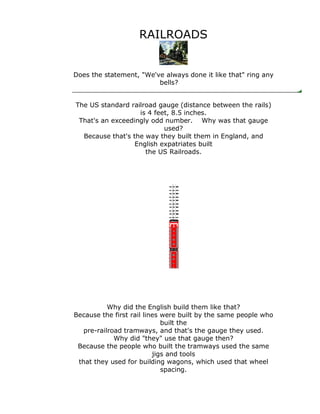Specifications why we should be careful with them
•
0 recomendaciones•345 vistas
Denunciar
Compartir
Denunciar
Compartir
Descargar para leer sin conexión

Recomendados
Recomendados
Más contenido relacionado
Similar a Specifications why we should be careful with them
Similar a Specifications why we should be careful with them (19)
Permanent Way of Railway & Components ?(part -1,2,3,4,5)

Permanent Way of Railway & Components ?(part -1,2,3,4,5)
THE GREAT INVENTIONS OF LAND AND PIPELINE TRANSPORT IN HISTORY AND ITS FUTURE...

THE GREAT INVENTIONS OF LAND AND PIPELINE TRANSPORT IN HISTORY AND ITS FUTURE...
Dr. Jaikrishna Memorial Lecture on Evolution of Bridges

Dr. Jaikrishna Memorial Lecture on Evolution of Bridges
Highway Planing and Alignment ; Historical Development of road Construction

Highway Planing and Alignment ; Historical Development of road Construction
Más de Shashidhar Kulkarni
Más de Shashidhar Kulkarni (20)
Último
Último (20)
Modular Monolith - a Practical Alternative to Microservices @ Devoxx UK 2024

Modular Monolith - a Practical Alternative to Microservices @ Devoxx UK 2024
Repurposing LNG terminals for Hydrogen Ammonia: Feasibility and Cost Saving

Repurposing LNG terminals for Hydrogen Ammonia: Feasibility and Cost Saving
Apidays New York 2024 - Accelerating FinTech Innovation by Vasa Krishnan, Fin...

Apidays New York 2024 - Accelerating FinTech Innovation by Vasa Krishnan, Fin...
Cloud Frontiers: A Deep Dive into Serverless Spatial Data and FME

Cloud Frontiers: A Deep Dive into Serverless Spatial Data and FME
ProductAnonymous-April2024-WinProductDiscovery-MelissaKlemke

ProductAnonymous-April2024-WinProductDiscovery-MelissaKlemke
Apidays New York 2024 - Passkeys: Developing APIs to enable passwordless auth...

Apidays New York 2024 - Passkeys: Developing APIs to enable passwordless auth...
Rising Above_ Dubai Floods and the Fortitude of Dubai International Airport.pdf

Rising Above_ Dubai Floods and the Fortitude of Dubai International Airport.pdf
Emergent Methods: Multi-lingual narrative tracking in the news - real-time ex...

Emergent Methods: Multi-lingual narrative tracking in the news - real-time ex...
EMPOWERMENT TECHNOLOGY GRADE 11 QUARTER 2 REVIEWER

EMPOWERMENT TECHNOLOGY GRADE 11 QUARTER 2 REVIEWER
"I see eyes in my soup": How Delivery Hero implemented the safety system for ...

"I see eyes in my soup": How Delivery Hero implemented the safety system for ...
Cloud Frontiers: A Deep Dive into Serverless Spatial Data and FME

Cloud Frontiers: A Deep Dive into Serverless Spatial Data and FME
Web Form Automation for Bonterra Impact Management (fka Social Solutions Apri...

Web Form Automation for Bonterra Impact Management (fka Social Solutions Apri...
Specifications why we should be careful with them
- 1. RAILROADS Does the statement, "We've always done it like that" ring any bells? The US standard railroad gauge (distance between the rails) is 4 feet, 8.5 inches. That's an exceedingly odd number. Why was that gauge used? Because that's the way they built them in England, and English expatriates built the US Railroads. Why did the English build them like that? Because the first rail lines were built by the same people who built the pre-railroad tramways, and that's the gauge they used. Why did "they" use that gauge then? Because the people who built the tramways used the same jigs and tools that they used for building wagons, which used that wheel spacing.
- 2. Okay! Why did the wagons have that particular odd wheel spacing? Well, if they tried to use any other spacing, the wagon wheels would break on some of the old, long distance roads in England, because that's the spacing of the wheel ruts. So who built those old rutted roads? Imperial Rome built the first long distance roads in Europe (and England) for their legions. The roads have been used ever since. And the ruts in the roads? Roman war chariots formed the initial ruts, which everyone else had to match for fear of destroying their wagon wheels. Since the chariots were made for Imperial Rome, they were all alike in the matter of wheel spacing. The United States standard railroad gauge of 4 feet, 8.5 inches is derived from the
- 3. original specifications for an Imperial Roman war chariot. And bureaucracies live forever. So the next time you are handed a specification and wonder what horse's ass came up with it, you may be exactly right, because the Imperial Roman army chariots were made just wide enough to accommodate the back ends of two war horses! Now, the twist to the story When you see a Space Shuttle sitting on its launch pad, there are two big booster rockets attached to the sides of the main fuel tank. These are solid rocket boosters, or SRBs. The SRBs are made by Thiokol at their factory at Utah. The engineers who designed the SRBs would have preferred to make them a bit fatter, but the SRBs had to be shipped by train from the factory to the launch site. The railroad line from the factory happens to run through a tunnel in the mountains. The SRBs had to fit through that tunnel.
- 4. The tunnel is slightly wider than the railroad track, and the railroad track, as you now know, is about as wide as two horses' behinds. So, a major Space Shuttle design feature of what is arguably the world's most advanced transportation system was determined over two thousand years ago by the width of a horse's ass.